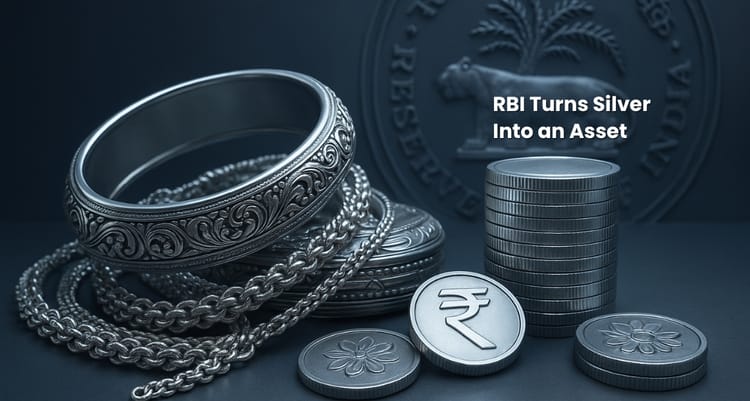Why Silver is the New Gold: RBI’s Big Move to Allow Loans Against Silver

We’ve all heard those catchy gold loan jingles —
“Jab ghar mein pada hai sona, tab kahe ko rona?”
But here’s a question: have you ever seen an ad for a silver-backed loan?
Probably not.
That’s because until now, silver never really made it to the mainstream lending system.
Gold was always the superstar — shiny, stable, and trusted across centuries.
But that’s about to change.
The Reserve Bank of India (RBI) just gave silver its long-overdue spotlight — officially allowing loans against silver under a new framework that could transform how Indians access credit.
Why Gold Always Won the Race
Gold has always been more than just jewellery. It’s emotion, history, and economics rolled into one.
Entire monetary systems once ran on gold. Central banks still hoard it to this day as a “safety net” during global crises. Even India used its gold reserves in 1991 to secure an emergency loan from the IMF during a balance of payments crisis.
So naturally, gold became the ultimate collateral. It’s easy to value, store, and sell.
But silver? Not so much.
Why Silver Never Made the Cut
Here’s the truth — silver is beautiful, but a bit high-maintenance.
Storage:
₹1 lakh worth of gold weighs only around 8 grams.
₹1 lakh worth of silver? Nearly 600 grams.
That means higher storage cost, more security, and more hassle.
Price Fluctuations:
Silver prices swing like a pendulum — mainly because half its demand comes from industries (electronics, solar panels, medical devices).
When global production slows down, silver prices drop fast.
Liquidity:
If a borrower defaults on a silver-backed loan, banks struggle to sell the metal quickly — and that’s a problem when markets move fast.
Lack of Regulation (Until Now):
Unlike gold, there was no clear RBI-approved rulebook for silver lending — no uniform purity checks, valuation, or resale procedure.
So, most silver loans happened informally through local lenders or small NBFCs, with risky terms and low transparency.
Enter the RBI: The Game-Changing Rulebook
The RBI recently introduced the Lending Against Gold and Silver Collateral Directions, creating a single national framework for all lenders — banks, co-operative banks, NBFCs, and housing finance companies.
They all must comply by April 2026.
That means no more confusion — just one clean, transparent system
What the New Silver Loan Rules Say
1️⃣ What You Can Pledge
Only ornaments, jewellery, and coins are allowed.
No silver bars, ingots, or ETFs.
2️⃣ No Speculation
Borrowers can’t use these loans to buy or trade in silver or gold.
These loans are for real financial needs — not investment bets.
3️⃣ Loan-to-Value (LTV) Ratio
- Up to 85% for loans ≤ ₹2.5 lakh
- 80% for ₹2.5–₹5 lakh
- 75% for loans above ₹5 lakh
Now gold and silver enjoy equal footing — same LTV rules, same framework.
4️⃣ The Gold-to-Silver Cap
Borrowers can pledge up to 10 kg of silver (vs 1 kg of gold).
This 10:1 ratio prevents banks from taking on too much silver risk, since silver is bulkier and more volatile.
Why the Timing is Perfect
Silver prices have surged nearly 40% in the past six months, thanks to growing industrial demand — and even Russia announcing it’ll add silver to its State Reserve Fund.
Despite this rally, silver remains “the common man’s gold.”
And that’s exactly why the RBI wants to make lending safer and more structured — to protect both banks and borrowers.
What This Means for Borrowers
This is a huge deal for millions of Indians.
A 2019 World Gold Council survey found that while 60% of women owned gold, 57% owned silver.
That’s nearly the same — but silver just sat idle, unused, and unmonetized.
Now, it can finally be put to use.
- You can get a loan up to ₹10 lakh by pledging silver jewellery or coins.
- For smaller loans (below ₹2.5 lakh), lenders won’t even ask for a credit history.
- That opens the door for farmers, gig workers, small traders, and women entrepreneurs who need quick cash without paperwork headaches.
It also helps borrowers build credit scores and gain formal financial inclusion.
What This Means for India’s Economy
This is more than a lending reform — it’s financial empowerment.
- It brings transparency to an unorganised market.
- It creates new lending opportunities for banks and NBFCs.
- It helps households unlock value from silver assets sitting idle in cupboards.
- And it deepens the reach of formal credit — right where it’s needed most.
By 2026, India’s lending landscape might just look a little shinier — with gold and silver both sharing the spotlight.
The RBI isn’t just changing the rules — it’s changing the narrative.
Silver is no longer the sidekick to gold.
It’s now a trusted financial asset that can power opportunity, inclusion, and growth.
Because in modern India, even your silver jewellery can tell a success story.
💬 FAQs
1️⃣ What is the RBI’s new rule about silver loans?
The RBI has created a single national framework that allows banks and NBFCs to offer loans against silver jewellery, coins, and ornaments — with the same LTV norms as gold loans.
2️⃣ Can I pledge silver bars or ETFs?
No. Only ornaments, jewellery, and coins are eligible for lending.
3️⃣ How much can I borrow?
Up to ₹10 lakh, depending on the value of your pledged silver.
4️⃣ Will I need a credit score?
Not for small loans (below ₹2.5 lakh). That makes it accessible even to new borrowers.
5️⃣ Why did RBI set a 10:1 ratio for silver and gold?
To limit risk exposure, since silver is bulkier, harder to store, and more volatile than gold.
6️⃣ What’s the benefit of this move?
It brings millions of Indians into the formal credit system and gives silver a legitimate role in the lending ecosystem.






Member discussion